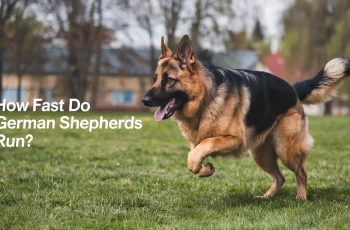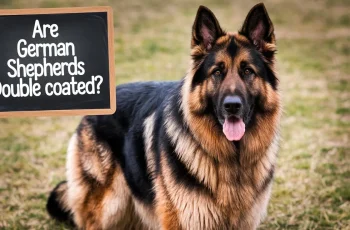German Shepherds, with their keen senses and loyal hearts, are brave but often rattled by thunderstorms. Their acute hearing amplifies thunder’s roar, while lightning and air pressure shifts spark anxiety, leading to barking, hiding, pacing, or chewing. This guide offers practical strategies to soothe your German Shepherd, turning stormy days into calmer moments for both of you.

Why Thunderstorms Scare Them
German Shepherds’ sharp hearing—detecting sounds up to 40,000 Hz—makes thunder overwhelming, like a sonic boom. Lightning’s flashes disorient their sensitive eyes, and barometric pressure changes can cause physical unease, triggering their fight-or-flight instincts. Past traumas or lack of storm exposure as puppies can heighten fears, making some Shepherds tremble while others merely perk up. Understanding their distress is the first step to helping them cope.
Create a Safe Space
Set up a cozy, storm-proof retreat:
- Location: A quiet basement, closet, or interior room minimizes noise. Avoid windows where lightning glints.
- Comfort Items: Pile blankets, a familiar bed, or a crate (door open) for security. Add their favorite toys for reassurance.
- Sound Barriers: Close curtains to dim flashes and play white noise, calming music, or a TV to muffle thunder’s rumble.
Introduce this space on calm days so it feels like a haven when storms hit. Let them choose to enter—never force them in.
Provide Physical Comfort
Your demeanor sets the tone:
- Stay Calm: Dogs mirror emotions, so keep your voice steady and relaxed to signal safety. Avoid over-coddling, which can reinforce fear.
- Gentle Touch: Pet slowly or offer lap time if they seek it. Some prefer space—watch their cues.
- Pressure Gear: A Thundershirt or snug blanket applies gentle pressure, mimicking a hug to ease nerves. Fit it snugly but not tight.
During a storm, sit nearby, offering quiet presence to anchor them without fussing.
Distract and Engage
Shift their focus from the storm with fun activities:
- Puzzle Toys: Treat-dispensing toys or Kongs stuffed with peanut butter keep their mind busy.
- Indoor Games: Play short rounds of fetch, tug, or “find the treat” in a hallway to burn anxious energy.
- Chew Toys: Durable bones or chews satisfy stress-induced chewing urges safely.
Start distractions early—before they’re too frazzled—to redirect attention effectively. Keep sessions light to avoid overwhelming them.
Calming Aids
For extra support, consider:
- Natural Supplements: Melatonin (vet-dosed) or chamomile chews promote relaxation without sedation.
- CBD Oil: Pet-safe, vet-approved CBD may reduce anxiety, but confirm legality and dosage first.
- Prescription Meds: For severe cases, vets may suggest anti-anxiety drugs like trazodone. Use only under guidance.
Test aids on calm days to ensure no adverse reactions, and never combine without professional advice.
Training for Confidence
Long-term relief comes from desensitization and counterconditioning:
- Desensitization: Play low-volume thunder recordings (online or apps), pairing with treats or play. Gradually increase volume over weeks, keeping sessions short (5-10 minutes).
- Counterconditioning: During real storms, reward calm behavior—sitting, lying down—with high-value treats like chicken. Ignore panic to avoid reinforcing it.
- Consistency: Practice regularly, even in clear weather, to build resilience. Progress slowly to avoid setbacks.
Training takes months but can transform storm dread into mild alertness, especially for young dogs.
When to Seek Professional Help
If fear escalates—think destructive panic, refusal to eat, or aggression—reach out:
- Veterinarians: Rule out health issues like ear infections amplifying noise sensitivity. They may prescribe meds for extreme cases.
- Behaviorists: Certified trainers design tailored plans, using advanced techniques like systematic desensitization.
- Holistic Experts: Some offer acupuncture or pheromone therapy (Adaptil diffusers) as complements.
Early intervention prevents phobias from worsening, especially if storms trigger year-round noise fears (fireworks, construction).
Extra Tips
- Exercise Before Storms: A tired Shepherd is less anxious. Walk or play early if weather forecasts predict thunder.
- Secure the Space: Block escape routes—panic can lead to bolting. Ensure ID tags and microchips are current.
- Monitor Diet: Avoid heavy meals before storms to prevent upset stomachs from stress.
- Track Progress: Note behaviors per storm to gauge improvement or flag issues for pros.

Conclusion
Thunderstorms don’t have to be a nightmare for your German Shepherd. With a cozy safe space, your calm presence, engaging distractions, thoughtful aids, and patient training, you can ease their fears and build confidence. Severe cases may need expert help, but most Shepherds respond to consistent care. Start today—create that retreat, grab some treats, and guide your loyal friend toward storm-time serenity. With love and effort, you’ll both weather any tempest, tails wagging!d training, you can help your German Shepherd cope with storms, finding what works best for them.



